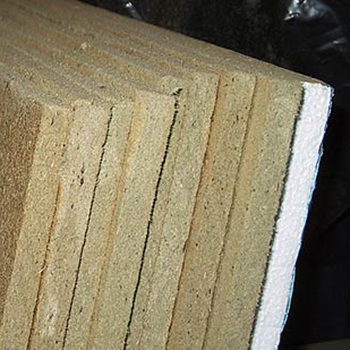 It’s a common question. Should I use one of several sound board products to help with soundproofing?
It’s a common question. Should I use one of several sound board products to help with soundproofing?
The various sound board products are marketed under many different names. In general they are made from waste material from the lumber industry. That’s a good thing.
They are light weight and a bit spongy, and that seems like a good thing so the hope of some sound isolation benefit springs forth.
Let’s look at the physics of what is available to us in our little soundproofing toolbox. There are 4 and only 4 elements of soundproofing:
- We have Decoupling. Having these sound boards on our studs doesn’t reduce the surface area of contact, not does it establish the required decoupled mass-air(spring)-mass system we’re looking for. So these sound boards do not decouple.
- We have Absorption. For absorption within a defined air cavity we want a medium density absorptive material. Sound boards are far too dense for the type of absorption we need so in effect, sound boards do not offer absorption.
- We have Mass. The low density of the sound boards certainly don’t replace drywall as they are at best 1/2 the weight of proper 5/8″ drywall. Sound boards do not offer significant mass.
- We have Damping. While the soundboards may be somewhat damped themselves, they do not significantly damp the drywall they are in contact with. Sound boards do not effectively damp what they are in contact with.
More info here: The Four Elements of Soundproofing
So the sound boards find themselves in an undefined category. They arguably do a little but not to the point where we would take up valuable resources to incorporate them.
Some other interesting facts:
Most assemblies specified by these manufacturers require that you install the drywall with screws that are anchored into the sound board, NOT the studs. The thought of my drywall being held in place by screwing to this somewhat dense cardboard isn’t comforting. The product test scores plummet when the surface drywall is properly attached to the studs.
Even with the questionable attachment recommendation, the overall STC scores (STC 51 on steel studs) are several points below what you would see if you used the same thickness of damped drywall (STC 61 on steel)
Lastly and most importantly, the low frequencies that are not measured by STC (STC stops at 125 Hz) are much superior in a more massive and highly damped system. If OITC calculations were available (measuring down to 80Hz), the differences in the systems would be even more dramatic.
The products from these manufacturers are well known in the acoustics industry to not be forthcoming with the raw data associated with their Transmission Loss Tests (ASTM e-90). Generally is the raw data is retained, there’s a reason.



















